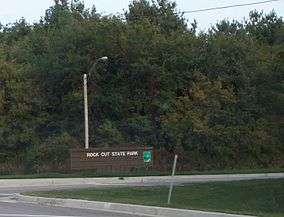Rock Cut State Park
| Rock Cut State Park | |
|---|---|
|
IUCN category III (natural monument or feature) | |
|
Welcome sign along Highway 173 | |
| Location | Winnebago County, Illinois, USA |
| Nearest city | Loves Park, Illinois |
| Coordinates | 42°21′06″N 88°58′35″W / 42.35167°N 88.97639°WCoordinates: 42°21′06″N 88°58′35″W / 42.35167°N 88.97639°W |
| Area | 3,092 acres (1,251 ha) |
| Governing body | Illinois Department of Natural Resources |
Rock Cut State Park is a state park of the U.S. state of Illinois. Located near Rockford in Winnebago County, it covers 3,092 acres (1,251 ha), enveloping Pierce Lake and Olson Lake. Rock Cut Park's main entrance is located on Highway 173, 1 mile west of Interstate 90.
History
During the 17th century, Native Americans that were driven from the East by the Iroquois Confederacy settled in today’s Northern Illinois. These Natives were originally in the region south of Lake Michigan and spoke Miami.[1] The land in which they settled became Rock Cut State Park. The region was occupied by the Mascouten between the mid-17th century to the early-to- mid-18th century. After the Mascouten lost influence on the land, it was taken up by the Winnebago.[2]
It is after this tribe, that the county in Illinois where the park is located is named. This land became the property of the United States as a result of Indian concessions after the Black Hawk War. Once under American control, the Scots that settled around Argyle which led to the Scottish settlement in Northern Illinois, along with some westward bound New Yorkers and New Englanders. The New Yorkers and New Englanders that made a settlement in this region now known as Rock Cut established a town known as Harlem. It was named after New York’s own Harlem.[3] The land acquisition proposition was made by Representative Pierce of Rockford, IL near the park, after whom the most popular fishing spot in the park known as Pierce Lake. The proposition was made in 1955 and the park was officially in existence two years later in 1957 on October 25.[4]
Layout
There are 268 campsites for overnight stays at the park. The reservations spread from class A, B, and C. The spaces open for camping are open year-round with many different accommodations for different seasons.[5] For instance, during the winter, electricity is provided to those who wish to have it available to them. There are Equestrian Trails for those with horses but the campground does not rent out horses. There is a massive series of trails for people that visit the park which has 40 miles (64 km) of trails that are established for hiking and running. Twenty three miles are designated mountain biking trails and fourteen miles of trails are devoted to horseback riding.[6]
Plant and Animal Life
Due to the plentiful supply of water and moisture throughout the park, wildlife and plants grow abundantly. Rock Cut State Park has one of the largest and few remaining grassland & wildflower prairies left. Waterfowl and Hawks; and other birds can be frequently spotted. Deer, fox, muskrat, beavers, opossum, raccoons, squirrels, and woodchucks all live prosperously in this region and are regularly seen by wildlife observers.[7] More than 100 distinct sorts of flowers grow in the park. The trees are thick and all over the land within the park’s confines. The water is replenished and stocked with largemouth bass, redear sunfish, bluegill, channel catfish, bullhead, muskellunge, northern pike, and walleye.[8]
Climate
The climate of Rock Cut is essentially typical for the region of the Midwest in which it is found. The climate can best be described as temperate. The summers can reach sweltering temperatures in the 90’s and the winters get as low as subzero levels in bitter wind. The fall and spring progressively grow to be more and more like the season they approach over time.
Recreation
The park offers a wide variety of activities for people of all ages and interests. Along the water there is sand volleyball, lifeguarding lessons, swimming, boat rentals, kayaking, canoeing, swimming lessons, and fishing. More land based recreation involves hunting, hiking, running, biking, horseback riding, picnicking, and camping. In the winter, cross country skiing is available. There is much to be seen and done at this sprawling park.
Gallery
 Long View of Lake Olson near sunset
Long View of Lake Olson near sunset One of the many hiking trails at Rock Cut State Park
One of the many hiking trails at Rock Cut State Park Lake Olson Beach and parking lot area
Lake Olson Beach and parking lot area
External links
- http://www.stateparks.com/rock_cut.html
- http://dnr.state.il.us/lands/landmgt/parks/r1/rockcut.htm
- http://www.prairiestateoutdoors.com/index.php?/pso/article/rock_cut_park_turns_50/
- State of Illinois Rock Cut State Park information
References
- ↑ http://www.stateparks.com/rock_cut.html
- ↑ http://dnr.state.il.us/lands/landmgt/parks/r1/rockcut.htm#History
- ↑ http://dnr.state.il.us/lands/landmgt/parks/r1/rockcut.htm#History
- ↑ http://www.prairiestateoutdoors.com/index.php?/pso/article/rock_cut_park_turns_50/
- ↑ http://www.prairiestateoutdoors.com/index.php?/pso/article/rock_cut_park_turns_50/
- ↑ http://dnr.state.il.us/lands/landmgt/parks/r1/rockcut.htm#History
- ↑ http://www.stateparks.com/rock_cut.html
- ↑ http://www.prairiestateoutdoors.com/index.php?/pso/article/rock_cut_park_turns_50/
